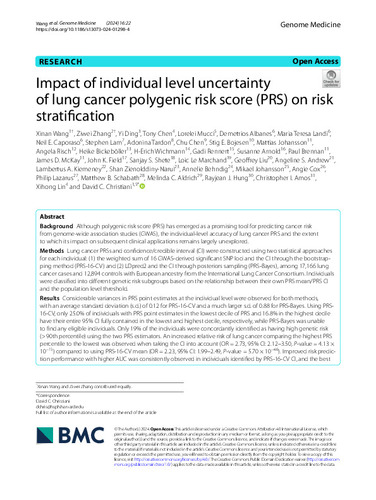Impact of individual level uncertainty of lung cancer polygenic risk score (prs) on risk stratification
Autor(es) y otros:
Fecha de publicación:
Versión del editor:
Citación:
Resumen:
Background Although polygenic risk score (PRS) has emerged as a promising tool for predicting cancer risk from genome-wide association studies (GWAS), the individual-level accuracy of lung cancer PRS and the extent to which its impact on subsequent clinical applications remains largely unexplored. Methods Lung cancer PRSs and confdence/credible interval (CI) were constructed using two statistical approaches for each individual: (1) the weighted sum of 16 GWAS-derived signifcant SNP loci and the CI through the bootstrap‑ ping method (PRS-16-CV) and (2) LDpred2 and the CI through posteriors sampling (PRS-Bayes), among 17,166 lung cancer cases and 12,894 controls with European ancestry from the International Lung Cancer Consortium. Individuals were classifed into diferent genetic risk subgroups based on the relationship between their own PRS mean/PRS CI and the population level threshold. Results Considerable variances in PRS point estimates at the individual level were observed for both methods, with an average standard deviation (s.d.) of 0.12 for PRS-16-CV and a much larger s.d. of 0.88 for PRS-Bayes. Using PRS16-CV, only 25.0% of individuals with PRS point estimates in the lowest decile of PRS and 16.8% in the highest decile have their entire 95% CI fully contained in the lowest and highest decile, respectively, while PRS-Bayes was unable to fnd any eligible individuals. Only 19% of the individuals were concordantly identifed as having high genetic risk (>90th percentile) using the two PRS estimators. An increased relative risk of lung cancer comparing the highest PRS percentile to the lowest was observed when taking the CI into account (OR = 2.73, 95% CI: 2.12–3.50, P-value = 4.13 × 10−15) compared to using PRS-16-CV mean (OR = 2.23, 95% CI: 1.99–2.49, P-value = 5.70 × 10−46). Improved risk predic‑ tion performance with higher AUC was consistently observed in individuals identifed by PRS-16-CV CI, and the bestperformance was achieved by incorporating age, gender, and detailed smoking pack-years (AUC: 0.73, 95% CI = 0.72–0.74). Conclusions Lung cancer PRS estimates using diferent methods have modest correlations at the individual level, highlighting the importance of considering individual-level uncertainty when evaluating the practical utility of PRS. Keywords Non-small cell lung cancer (NSCLC), Polygenic risk score (PRSs), Cancer control, Population science, Genetic epidemiology
Background Although polygenic risk score (PRS) has emerged as a promising tool for predicting cancer risk from genome-wide association studies (GWAS), the individual-level accuracy of lung cancer PRS and the extent to which its impact on subsequent clinical applications remains largely unexplored. Methods Lung cancer PRSs and confdence/credible interval (CI) were constructed using two statistical approaches for each individual: (1) the weighted sum of 16 GWAS-derived signifcant SNP loci and the CI through the bootstrap‑ ping method (PRS-16-CV) and (2) LDpred2 and the CI through posteriors sampling (PRS-Bayes), among 17,166 lung cancer cases and 12,894 controls with European ancestry from the International Lung Cancer Consortium. Individuals were classifed into diferent genetic risk subgroups based on the relationship between their own PRS mean/PRS CI and the population level threshold. Results Considerable variances in PRS point estimates at the individual level were observed for both methods, with an average standard deviation (s.d.) of 0.12 for PRS-16-CV and a much larger s.d. of 0.88 for PRS-Bayes. Using PRS16-CV, only 25.0% of individuals with PRS point estimates in the lowest decile of PRS and 16.8% in the highest decile have their entire 95% CI fully contained in the lowest and highest decile, respectively, while PRS-Bayes was unable to fnd any eligible individuals. Only 19% of the individuals were concordantly identifed as having high genetic risk (>90th percentile) using the two PRS estimators. An increased relative risk of lung cancer comparing the highest PRS percentile to the lowest was observed when taking the CI into account (OR = 2.73, 95% CI: 2.12–3.50, P-value = 4.13 × 10−15) compared to using PRS-16-CV mean (OR = 2.23, 95% CI: 1.99–2.49, P-value = 5.70 × 10−46). Improved risk predic‑ tion performance with higher AUC was consistently observed in individuals identifed by PRS-16-CV CI, and the bestperformance was achieved by incorporating age, gender, and detailed smoking pack-years (AUC: 0.73, 95% CI = 0.72–0.74). Conclusions Lung cancer PRS estimates using diferent methods have modest correlations at the individual level, highlighting the importance of considering individual-level uncertainty when evaluating the practical utility of PRS. Keywords Non-small cell lung cancer (NSCLC), Polygenic risk score (PRSs), Cancer control, Population science, Genetic epidemiology
ISSN:
Patrocinado por:
National Cancer Institute [U19-CA203654, R35-CA197449, 5U01CA209414]; NHGRI [U01-HG009088, U01HG012064]
Ficheros en el ítem





